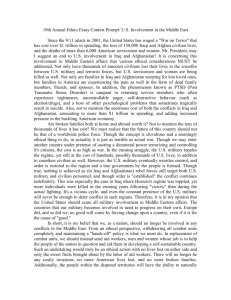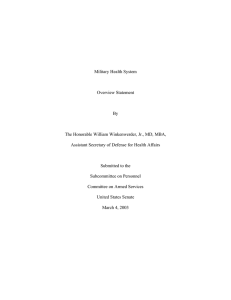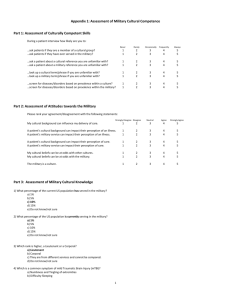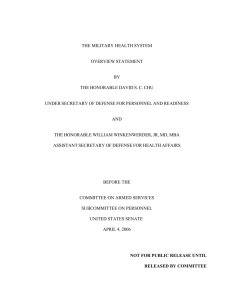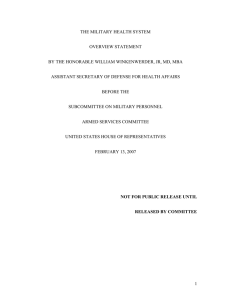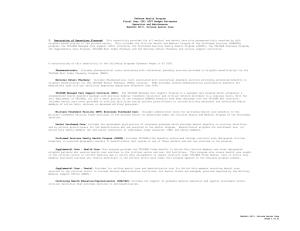JOINT OVERVIEW STATEMENT
advertisement
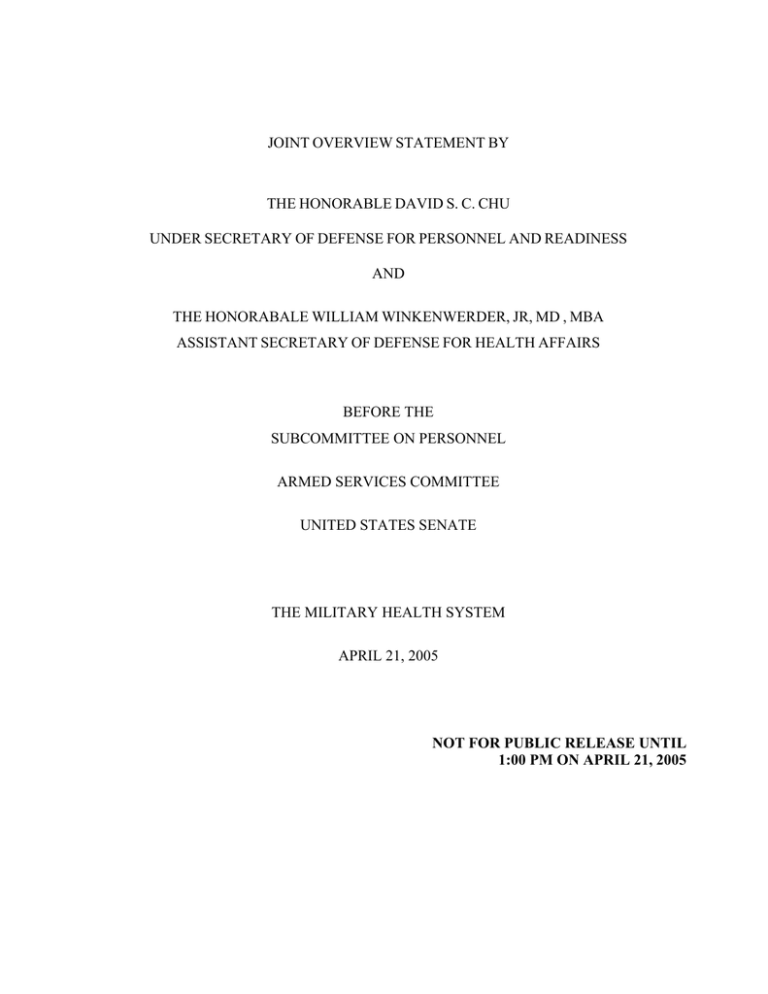
JOINT OVERVIEW STATEMENT BY THE HONORABLE DAVID S. C. CHU UNDER SECRETARY OF DEFENSE FOR PERSONNEL AND READINESS AND THE HONORABALE WILLIAM WINKENWERDER, JR, MD , MBA ASSISTANT SECRETARY OF DEFENSE FOR HEALTH AFFAIRS BEFORE THE SUBCOMMITTEE ON PERSONNEL ARMED SERVICES COMMITTEE UNITED STATES SENATE THE MILITARY HEALTH SYSTEM APRIL 21, 2005 NOT FOR PUBLIC RELEASE UNTIL 1:00 PM ON APRIL 21, 2005 Mr. Chairman, distinguished members of this committee, thank you for the opportunity to discuss the Military Health System. Today, the Armed Forces of the United States have more than 275,000 service men and women deployed around the world in support of our national military commitments, including those serving in Afghanistan and Iraq. The Department is firmly committed to protecting the health of these and all service members, before, during and after their deployment and to our other healthcare beneficiaries, who now number more than 9 million. When we assumed our positions in the Department of Defense, we faced the tragic events of September 11th, and our nation was about to embark on the military campaign in Afghanistan against the Taliban and Al Queda. Then, within a very short period, our country suffered suspected internal anthrax attacks against members of Congress, the media and others. From those events, we found that the country had a very limited supply of anthrax and smallpox vaccine, and limited means to detect a domestic attack by such bioweapons. Also during that period following September 11th, there was neither a Department of Homeland Security nor a Northern Command, and almost no concept of “interagency” collaboration. Efforts to improve intelligence gathering and analysis had barely begun. Internationally, Saddam Hussein and his brutal sons, other Baathist henchmen, and terrorists were relatively free to come and go as they pleased, and to carry out attacks on innocent people in the Middle East and elsewhere around the world. In short, the world had arrived at a very dangerous point in time. In many respects during that period, we were just beginning to understand the scope and nature of our new enemy. In just a little more than three years, the United States has met several stern tests – tests of will, conviction and sacrifice. We have come a long way. Today, there are many signs of success and hope. Clearly, we are seeing the beginnings of a new and perhaps hopeful future for the Middle East. As an example of this change, we have seen Palestinians democratically elect a leader for Palestine who is now working with the Israelis; a democratically 1 elected government in Afghanistan that continues its path of rebuilding a bright future for its citizens; and, for the first time in more than 50 years, more than 8 million Iraqi citizens, in defiance of insurgents, recently voted to begin the developmental process of creating an elected government. We are also beginning to see positive changes in countries such as Lebanon, Pakistan, Libya, and Saudi Arabia. Terrorists are on the run and finding fewer and fewer places to hide. In Afghanistan and Iraq, and elsewhere, the United States has killed or captured thousands of terrorists and we continue to face a vicious and malignant insurgency -- a mix of old regime loyalists and new fanatics. We do not stand alone, but are engaged with many other countries in this international fight. Although Iraq is still a battleground, it continues its rebuilding efforts, not only the result of the war, but also to repair more than 30 years of designed neglect by Saddam Hussein. Not long ago, Dr Winkenwerder had the opportunity to visit service members and our medical staffs who are so hard at work in Afghanistan, and to compare the conditions found there now to what he observed there just two years ago. He reported that morale was high and the performance of our people -- superior. We know you too salute the extraordinary efforts of these honorable troops who truly are serving our nation so well. During his time in Afghanistan, Dr Winkenwerder also had the opportunity to meet with President Hamid Karzai. Without question, he found him an outstanding leader who, with our help and the help of other allies, continues unparalleled progress toward creating a better life for his country and its citizens. Throughout all of these world events since September 11, 2001, the leadership of the U. S. military has had a clear and consistent message to our men and women in uniform -- we will take care of you because you are facing dangers and hardships daily as you go about the task of carrying out our government’s missions, protecting Americans, and advancing the cause of freedom and democracy in the world. Throughout the Department of Defense, the men and women of the Military Health System contribute every day to the care and comfort of our service members. These medical professionals, from the doctors and scientists to nurses, technicians and medics work around the clock keeping America’s military fit, safe, healthy, and protected so that it can carry out its mission – a mission that, perhaps, has never before been as complex, 2 challenging, or far-reaching as we find today. At the same time, these medical professionals also are defining, preparing and participating with others at the national level in improving the nation’s medical emergency preparedness should the unthinkable happen. As some have put it, we are the “go-to team” on the other end of that 911 phone call when local, state or other federal assets are overwhelmed. Military Health System Funding Before describing our military health activities, we would like to address our Defense health funding situation and highlight initiatives to manage costs. Defense Health Program (DHP) costs continue to rise due to increased utilization of the Military Health System (MHS). The Fiscal Year (FY) 2006 DHP funding request is $19.8 billion for Operation and Maintenance, Procurement and Research, Development, and Test and Evaluation Appropriations to finance the MHS mission. We project total military health spending to pay for all health-related costs including personnel expenses, and retiree health costs, to be $33 billion for FY 2006. To fund this growth, the Operation and Maintenance Appropriation submission is 11 percent more than the FY 2005 appropriated amount. This funding growth is the result of benefit changes for our beneficiaries, to include the Reserve Components, increased healthcare costs in the private sector, and the decision of MHS-eligible beneficiaries, mainly our retirees, to drop private insurance coverage and rely upon TRICARE. The Department has taken several actions to better manage resources. The MHS is implementing performance-based budgeting, focusing on the value of services delivered rather than using old cost reimbursement methods. We are introducing an integrated pharmacy benefits program that uses a standardized formulary that is clinically and fiscally sound. Federal pricing of pharmaceuticals in the TRICARE retail pharmacy program will help significantly to contain costs. Quality management programs continue to ensure that care provided is clinically appropriate and within prescribed standards. Performance-based budgeting. With this budgeting approach, we intend to base Military Treatment Facility (MTF) budgets on workload output such as hospital admissions, prescriptions 3 filled and clinic visits, rather than on historical resource levels such as number of staff employed, supply costs, and other materials. We are in the first year of a planned four year transition to this new Prospective Payment System which will provide incentives and financial rewards for efficient management. Integrated pharmacy benefits program. The redesign of our pharmacy programs into a single, integrated program, beginning in June 2004, simplifies and allows us to more effectively manage this $5.5 billion program. We are standardizing formulary management, achieving uniform access to all medications, enhancing portability, and involving beneficiaries in formulary decision-making. We will promote the use of more cost-effective products and points of service. Application of federal pricing for the retail pharmacy benefit will allow the Department to obtain manufacturer refunds for medications obtained through our broad retail network. We currently use federal pricing for mail order and MTF pharmacy services. Quality management programs. We continue to improve the quality of care delivered throughout the MHS, employing sound management practices and metrics to ensure appropriateness of care. We monitor the health of our population using Healthy People 2010 goals as a benchmark, and we measure the quality of care provided using Joint Commission on Accreditation of Healthcare Organizations Oryx indicators. Our new healthcare contracts use best-practice principles to improve beneficiary satisfaction and control private sector costs. Civilian contract partners must manage enrollee healthcare and can control their costs by referring more care to MTFs. In concert with these new contracts, and the implementation of the Prospective Payment System, we need the flexibility to flow funds between MTFs and the private sector. Currently, MTF revised financing funds are in the private sector budget activity group. Restricting the movement of DHP funds does not allow MTFs to use these revised financing funds to increase productivity and workload without priorapproval reprogramming. We appreciate the Congressional intent to protect direct care funding. However, the current restrictions on funding adversely affect MTFs as well as care in the private 4 sector. We urge you to allow the MHS to manage our funds as an integrated system. Funds must be allowed to flow on a timely basis to where care is delivered. We seek your help in restoring this much needed management flexibility. Battlefield Medicine Success Today, military medicine is saving hundreds of lives that previously would have been lost on the battlefield. Better training, advanced equipment, and talented and dedicated Soldiers, Sailors, Airmen and Marines also contribute to this success. Fewer than 2 percent of wounded service members who make it to a source of medical care die of their wounds. This is the lowest figure in the history of warfare. On its own, this milestone is a remarkable accomplishment. It was achieved due to the proficiency and professionalism of our medical personnel who have advanced battlefield medicine and medical transportation to new levels of capability. Our people are also doing an extraordinary job preventing illnesses and maintaining health. This progress is mirrored in our disease and non-battle injury rates that are only about four percent in Iraq – which also are the lowest in military history; this four percent is about 50 percent less than that experienced during the 1991 Gulf War. Despite these historically low rates, the Department of Defense continues to seek even better ways to care for our service members. We have new programs and initiatives, for example, to take care of the severely wounded. While service members are surviving injuries in record numbers, we now must treat and care for those severely injured as we help them return to productive lives. Among these new programs are the Assistive Technology Centers for amputees at Walter Reed and Brooke Army Medical Centers, and others such as the Army’s Disabled Soldier Support System. General Bill Fox, Commander of Brooke Army Medical Center, the Army Vice Chief of Staff, and the Sergeant Major of the Army, opened the Brooke Amputee Care Center this January. The aim of this Care Center is to return patients to their “highest possible level of activity." It does so by incorporating a full range of amputee care at one site, including services for orthopedics, rehabilitation, occupational therapy, physical therapy and prosthetics. It also offers these service members quick access to social work and Department of Veterans Affairs 5 counselors, when needed. The Walter Reed and Brooke centers also provide an opportunity for additional research in rehabilitation and prosthetic design. Walter Reed Army Medical Center, the Department’s first amputee care center, has cared for more than 200 troops from operations in Iraq and Afghanistan. The combined effort of the Centers’ staffs is remarkable and it’s just amazing to see these health professionals attain their goals of returning seriously injured service members to a “tactical level of athleticism," including such activities as running track, bicycling, wall-climbing and rappelling. It is also satisfying to see the optimism and “true grit” of our injured and wounded warfighters as they meet the challenges of their particular situation. Improving Mental Health Services During the past decade, we have learned valuable lessons. Among these are identifying and gaining a better understanding of the health effects of deployments and operations; we are happy to report that the Department has made great progress in these important areas. To date in the current conflict, service members have completed more than one million pre- and postdeployment health assessments. Nearly 90 percent of this information is collected and transmitted to the United States electronically. This information helps us to improve follow-up care and treatment, ensures our people get the care they need, and assists the Department with its medical planning efforts. War is always a difficult undertaking. Stress, uncertainty, separation from loved ones, daily risk of death or bodily harm and, frankly, witnessing of horrible events – take a mental toll on many of our service members. These mental health issues strike even our strongest and most brave. This is a challenge we must meet -- and we believe we are doing so in a concerned, straightforward and timely fashion. The Department today has a better understanding than ever before of the effects of combat and other rigors of war on our service members. In recent years, the Military Services began deploying combat stress control teams at the unit level and using them far forward in combat zones. These specialized teams do a fantastic job; they are making a real difference. They are part of the forward edge of our healthcare continuum, which extends back to include post-deployment health assessments, family support services, and reintegration into home life. 6 Another lesson that we’ve learned is that the period of highest risk for mental and family readjustment problems may be weeks after someone returns home. With this in mind and in consideration of the potential for physical health issues to arise once service members return, we recently directed an additional post-deployment health assessment – a follow-up program that expands upon our previous efforts. We recognize that no one who goes to war remains unchanged. However, not everyone is affected in the same way and not everyone has mental health or readjustment issues. But, some, a minority, do have health issues, and their health is our concern. This new effort will include a short interview questionnaire to be filled out by all service members -- including Reservists and Guardsmen, three to six months after they have returned home. Once they complete the questionnaire, service members may be referred to a healthcare provider to discuss issues of concern and obtain needed assistance. The intent of this program is to help determine the health status or personal situation of the service member with a focus on discovering any readjustment issues or problems. To get to the heart of issues, counselors will ask such questions as: “How are you doing”? “How is your family”? If things are not well, we want our service members to know that help is available. We believe that with this new disciplined and caring process, we can reach those who may need help and make a real difference where it is needed. As you know, there remains a common, general public perception in our country -- a stigma – regarding the need for mental health services. We believe that through this new, followon reassessment tool, we reduce this “stigma” as an issue or barrier to needed care. Military Vaccine Program In this War on Terrorism, the Department has had programs to protect our service members against the threat of Smallpox and Anthrax, which we believe to be two potential bioterrorism weapons of concern. To date, we have vaccinated more than 1.3 million Department members against Anthrax and over 700,000 for Smallpox. These programs have an unparalleled safety record and are setting the standard for others in the civilian sector. Our Anthrax program currently is on hold, the result of a Federal district court judgment last October. We worked with the Department of Health and Human Services, the FDA and the Court to restart this important 7 program, and I am optimistic that shortly we will return to providing our service members this vital protection. Our service members deserve the protection the Anthrax vaccine provides. Bio-Threats We want you and the world to know that the Department is at the forefront of science, research and development for medical countermeasures to biological threats, and for sensors, detectors and surveillance systems to protect all of us from a chemical or biological or radionuclear attack. For example, just three years ago, the Pentagon had a research idea -- an environmental detection system to detect airborne pathogens. Today, this vital protection system, known as Biowatch, has been installed in more than 30 cities throughout the nation, including Washington D.C. Additionally, the President’s Project BioShield program provides nearly six billion dollars to develop an effective stockpile of protective vaccines and drugs. Similarly, we played a key role in developing the “National Interagency Biodefense Campus” (NIBC) at Fort Detrick, MD to accelerate research on medical countermeasures. We are most pleased to recognize the outstanding leadership of Fort Detrick’s Major General Martinez-Lopez in developing the NIBC. This project also involves close coordination with the Departments of Homeland Security and Health and Human Services and other Federal agencies. Finally, on the research front, the Department continues its work on other vaccines and measures that have great promise toward effectively combating such diseases as HIV/AIDS, tuberculosis and malaria. Not only do these efforts hold great potential with significant benefits to our service members, but they can help in worldwide humanitarian efforts as well. Humanitarian Operations Natural disasters and humanitarian issues are constantly a challenge to the world. The Department’s medical assets often provide unique capabilities not found elsewhere. The recent tsunami in South Asia was unprecedented in its devastation. A worldwide response developed very quickly to support those affected by that incredible disaster. In cooperation with many other nations and multi-national groups, the U. S. has been a major contributor to the relief efforts. And, once again, the Department and the Military Health System demonstrated substantial and 8 unique capabilities of support for humanitarian operations; we helped make a major difference to the people of South Asia. Dr. Winkenwerder had the opportunity to observe part of DoD’s effort when he recently visited Indonesia and our crew aboard the USNS Mercy, our hospital ship that also is hosting a number of non-government agencies providing humanitarian aid and support. He was very impressed with those operations and we find it encouraging, especially the precedent of partnering the US military and Federal Government with non-government organizations to provide much needed care. The result has been strengthened good will and trust between our nation and those we assisted. Medical Ethics and Detainee Healthcare In the shadow of these great accomplishments, and the outstanding reputation of U.S. military medicine, have come allegations and reports that a few members of the military healthcare team may not have acted properly or met their ethical obligations. These allegations and reports are deeply disturbing to us and to the leaders of military medicine. We want you to know that these reports have been fully investigated (some investigations and findings are still pending) and our policies and guidance and training have been reviewed and, where needed, revised. We have been addressing these matters in a straightforward way, and making whatever improvements are needed. Our message to all levels of the military medical community is that, at all times, our people always must do the right thing and they must always act ethically. For the medical care provided to detainees under U.S. control, we will rely on the professional judgment of our medical staffs and ensure that the standards provided to detainees is comparable to that provided to U.S. members. Importantly, you should know that the lives of hundreds of insurgents and detainees have been saved by superior medical care and treatment provided by U.S. military personnel, often under the same trying conditions we find in treating our own people. We expect our military medical personnel to report suspected detainee mistreatment, including any mistreatment noted during interrogation sessions. Investigations are ongoing and should we discover violations, we will hold people accountable. Currently, the Army and Joint Chiefs of Staff are addressing several recommendations from the various reports and investigations regarding medical issues for detainees in Iraq and Afghanistan. Additionally, over this last year, 9 military leaders in Iraq have made numerous improvements regarding medical care of detainees. For example, the medical treatment facility at Abu Ghraib has been expanded to include a 210person, 52-bed field hospital. Above all, our policies, simply stated, require that all detainees be treated humanely. U.S. law and policy condemn and prohibit torture, and U. S. personnel are required to follow this policy and applicable law. Healthy Choices for Life We believe that the long-term, life-style choices people make can affect positively the readiness of our forces. To encourage these positive life-style choices, we have embarked on a new effort, one that reflects our commitment to fostering healthy lifestyles among our service members and other beneficiaries of the Military Health System. It is clear that we must work harder and smarter to reduce the negative affects of unhealthy behavior choices. Indeed, the negative effects on our military community of destructive choices are a cause for concern. For example, according to DoD cost estimates, tobacco use by the active duty force generates a $1.6 billion annual expense in medical care. Combined with the adverse consequences of obesity and binge drinking, the health of our military population suffers significantly. Force readiness depends on the good health of members of our armed forces. Longterm success in efforts to promote healthy choices among our members and their families could be among our most valuable and enduring efforts. While individual health is a personal responsibility -- developing and maintaining a healthy and fit force is everyone’s responsibility. Our patients tell us that we – the Department – are their most trusted sources of advice in such matters. Knowing that, we believe we can help our military members and their families make a difference in their life-style choices. In that spirit, over the next two years, through a demonstration project called “Healthy Choices for Life,” we will focus on building healthier communities through education, intervention and treatment. We have an enthusiastic team of health professionals working with others in the Department to meet this challenge. Our goal is to significantly improve members’ 10 health through lifestyle changes, thus enhancing the readiness of the Armed Forces, and eventually reducing the cost to our military health system that adverse choices impose. TRICARE, the Military Health Plan The TRICARE Program, our healthcare plan for our 9 million beneficiaries has now fully transitioned to new regional alignment and contracts, which include incentives for positive outcomes based on improved customer service. This transition was a momentous accomplishment and required dedicated work by a highly motivated professional team. Today’s contracts have a stronger customer service focus, apply best commercial practices, and support our medical treatment facilities—indeed, our military medical facilities remain at the core of our system. In spite of our efforts to manage more efficiently, total spending for the Military Health System, including the Retiree Accrual Fund, will reach $36 billion in 2005. Spending has essentially doubled in just the past four years! Our program growth is very rapid, and it appears likely to exceed $50 billion within five years. Additionally, if current trends continue, over 75 to 80 percent of that spending will be for individuals no longer on active duty or their family members. The expansion of benefits, such as those for our senior retirees, contributes to the growing size of our budget. But, so do other program elements. For example, our total pharmacy program has increased five-fold, that’s 500 percent since 2001 and now stands at over $5 billion annually. Our leaders of military medicine must apply full attention and best management efforts to these matters. We have informed the Service chiefs and vice chiefs, Service secretaries, and other department leaders, including Secretary Rumsfeld, of the facts about our spend patterns, cost trends, funding needs, how we are addressing cost increases, and more. Through these efforts, we have achieved a much better understanding about the financial aspects of our Defense health program and have received solid funding commitments. As a result of these exchanges, we are confident about the state of our program in the near term. However, looking to the medium to longer term, quite candidly, we are concerned. We face tremendous challenges with a benefit design that does not always reward the efficient use of care. Further, we are increasingly out of step with the benefit design approaches and trends of the 11 private sector. We must address these issues, engage in constructive dialogue, and do what is right for our current and our future generations. My primary goal is to ensure the military has a high quality, yet affordable, health benefit program for the long term. Sharing Initiatives with DVA We continue to explore new avenues of partnership with the Department of Veterans Affairs. Our Executive Council structure serves as the setting in which the Departments jointly set strategic priorities, monitor the implementation of those priorities and ensure that appropriate accountability is incorporated into all joint initiatives. The Joint Executive Council recently reviewed and updated the Joint Strategic Plan (JSP) for FY 2005 which includes goals and objectives for the year, as well as performance metrics in the following areas: • Leadership Commitment and Accountability • High Quality Health Care • Seamless Coordination of Benefits • Integrated Information Sharing • Efficiency of Operations • Joint Contingency/Readiness Capabilities We have worked closely with the VA to initiate the demonstrations projects required by the NDAA of FY 2003, as well as the Joint Incentive Fund (JIF) projects required by the same legislation. Seven demonstrations are now underway, twelve incentive fund projects are in varying stages of initiation and 56 new JIF proposals have been submitted for review. We are especially pleased with our work with the Department of Veterans Affairs for the seamless, responsive and sensitive support to soldiers and marines as they return to duty or transition from active duty to veteran status. An important aspect of this transition is having the individual medical records available when a separated service member presents at a VA hospital for the first time. We made significant strides forward by transferring to DoD electronic health 12 information of service members who leave active duty to a central repository at the VA Austin Automation Center. Through this repository, VA clinicians and claims adjudicators have access to DoD laboratory results, radiology results, outpatient pharmacy data, allergy information, discharge summaries, consult reports, admission, disposition and transfer information, elements of the standard ambulatory data records and demographic data. To date, we have transferred this electronic health information on more than 2.9 million separated service members to this repository, and the VA has accessed more than 1 million of those records. We believe that this collaborative effort with the VA has been going extremely well and together, the DoD and VA are improving services to our veterans. Reserve Components Health Benefits At your direction, we are implementing the new TRICARE Reserve benefits that will ensure the individual medical readiness of members of the Guard and Reserve, and contribute to the maintenance of an effective Reserve Component force. The Guard and Reserve are doing an outstanding job and they deserve an outstanding benefit. We will provide that for them. We have made permanent their early access to TRICARE upon notification of call-up, and their continued access to TRICARE for six months following active duty service for both individuals and their families. We are implementing the TRICARE Reserve Select (TRS) coverage for Reserve Component personnel and their families who meet the requirements established in law. TRS is a premium-based healthcare plan, at very attractive rates, available to eligible members of the National Guard and Reserves who have been activated for a contingency operation, on or after September 11, 2001. This program will serve as an important bridge as the Reserve and Guard members move back to other employment and the utilization of the private health care market. The Way Ahead As we begin the second four years of this Administration, it is an appropriate time to contemplate the way ahead for our Military Health System. The mission is clear -- to support our men and women fighting the Global War on Terror, the people who are helping to bring security and freedom to Iraq and Afghanistan, and to care for our Armed Forces wherever they serve 13 around the world. Our top priorities for our health system today are simple. First, to continue to do our utmost to care for service members who go in harm’s way. Second, to ensure our health benefit remains intact, affordable and effective. We have challenged the leadership of the Military Health System to be creative and diligent in the pursuit of these missions and priorities. We will advance our programs to care for our deployed heroes -- our returning wounded from Iraq and Afghanistan will have special focus. We have made great strides in this direction, but further improvements are possible. The Department continues to lead and cooperate with other federal partners in the biodefense of our country and supporting the enhancement of emergency medical preparedness. We will follow through on our TRICARE governance implementation and together address remaining and emerging issues in our new framework. In key areas we have worked with our private sector partners to identify needed policy changes…and to soon implement these changes. We will work to complete the Medical Readiness Review, and implement the final recommendations of the Base Realignment and Closure Commission to be released later this year. We will fully implement our strategic and business planning processes to ensure we effectively address readiness, capital needs, and changing infrastructure. These processes are not simply a window for us in Washington, but a productive way for MTFs, regional directors, and TRICARE managers to manage for the next 10 years or more. We will pursue higher levels of system efficiency and clinical effectiveness and deploy information technologies and management systems that support greater performance, clarity and accountability. We will implement critical new initiatives such as revised financing, prospective payment, DRGs, improved billing and coding, and the CHCS II System. The Military Health System enjoys a position of national leadership with respect to information technology. Our electronic health record system is the most sophisticated and far 14 reaching of any in the world. We are on track to implement it fully within the next 24 months. Today, on average, nearly 20,000 patient visits daily are being captured by this new system. We have an opportunity, even an obligation, to lead—and so we will. Support to the Severely Wounded Each of the Services has initiated an effort to ensure that our seriously wounded Service members are not forgotten - medically, administratively, or in any other way. To facilitate a coordinated response, the Department has established the Military Severely Injured Joint Support Operations Center. We are collaborating, not only with the military Services, but also with other departments of the federal government, nonprofit organizations, and corporate America, to assist these deserving men and women and their families. A number of our severely injured Service members will be able to return to duty, thanks to their dedication and commitment, and the phenomenal quality of military medicine. Some, however, will transition from the military and return to their hometowns or become new members of another civilian community. These are capable, competent, goal-oriented men and women - the best of our nation. We will ensure that during their rehabilitation we provide a “case management” approach to advocate for the Service member and his or her family. From the Joint Support Operations Center here in Arlington, Virginia, near the seat of government, to their communities across America, we will be with them. This will continue through their transition to the Department of Veterans Affairs, and the many other agencies and organizations providing support to them. Our goal is to provide long term support to ensure that no injured Service member is allowed to fall through the cracks. 15 Conclusion The military medical community has often been a powerful influence in building national relationships that foster freedom and liberty. Today, we also directly support our Service members who fight to help others secure their freedom. We face real challenges in the months and years ahead in this fight for freedom and liberty. Our Military Health System is truly a precious national asset, and we are most pleased to have the opportunity to help shape and lead it. The men and women of the Military Health System have worked very hard at research, to protect, to care for and to treat, to manage and to lead. The reason military medicine has succeeded and why it will continue to succeed goes beyond ‘hard work’ -- it goes to the will and character of the American people. We are confident that our mission -- caring for the uniformed service members who keep this nation safe and secure, and to care for their families -- has no greater calling or cause! The Department of Defense has made tremendous progress in force health protection and surveillance since the Gulf War, and quite a bit since the beginning of Operation Iraqi Freedom. The groundwork has been laid for even greater progress in the near future and we are firmly committed to continued improvement in protection for the health of our service members and in the everyday care and support for all of our beneficiaries. The medical personnel of our combined services have our heartfelt appreciation and full support for their outstanding work. Thank you. 16
